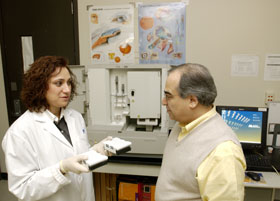Researchers Discover New Glaucoma Gene
 |
| Researchers Mansoor Sarfarazi, right, and Dr. Sharareh Monemi discuss samples in their lab at the Health Center. The two have discovered a gene that is expected to help in the diagnosis and treatment of glaucoma. |
|
Photo by Peter Morenus |
Researchers at the Health Center have discovered a gene that causes a type of late-onset glaucoma.
The discovery was made by Mansoor Sarfarazi, a professor of human molecular genetics and director of the Molecular Ophthalmic Genetics Laboratory, and his graduate assistant, doctoral candidate Dr. Sharareh Monemi.
The gene (WDR36) is the third glaucoma-causing gene discovered by the laboratory.
The discovery will enhance screening for late-onset primary open-angle glaucoma. It will improve early diagnosis, facilitating earlier and better treatment, and will also advance the likelihood of gene-targeted therapies.
“This discovery will improve screening of high-risk individuals, and help identify those who could develop glaucoma decades later,” says Sarfarazi. “It will also help in designing more effective treatments for them.
“But the real work has just begun,” he adds. “There’s always more to learn.”
Dr. Peter J. Deckers, dean of the School of Medicine and executive vice president for health affairs, says Sarfarazi’s discovery is the latest example of the high quality scientific research now being conducted at the Health Center.
“This laboratory continues to work at the cutting edge of gene definition as a causative factor in serious ocular problems,” he says.
“As a result of their seminal contributions, these researchers have established for themselves and for the Health Center an international reputation in the new biology of this decade – specifically molecular diagnosis and, in time, molecular treatment,” adds Deckers.
Glaucoma affects more than 2 million Americans and more than 33 million people worldwide. After cataracts, it is the second most common cause of blindness. Although there is no cure, medication or surgery can be effective treatments.
The numbers involved in the discovery were daunting: the researchers were originally faced with a universe of 3 billion base pairs of DNA material. That number was winnowed to 35 million pairs, by locating the region of the chromosome where the gene was thought to reside.
Additional study further narrowed the number to 7 million, and colleagues working on a similar problem in Oregon helped narrow it further to 2 million base pairs of DNA.
In the end, Sarfarazi and Monemi investigated more than 34,000 base pairs of DNA before the mutation they were searching for turned up.
“Of the original 35 million base pairs, only one change eventually proved to be significant,” says Sarfarazi. “It was like searching for the proverbial needle in a haystack.”
The gene is conserved in almost the same form along the evolutionary path from mouse to rat, dog, chimp, and human, Sarfarazi says. Essential genes, vital to an important biological function such as vision, change less through evolution than other non-essential genes, he notes.
Monemi, a physician, says the work is important for patients.
“Losing your vision to glaucoma in later life is terrible,” she says. “This work can help make that loss less common.”
Sarfarazi’s lab also discovered a gene known as Optineurin that causes adult-onset primary open angle glaucoma in 2002.
And in 1997, he identified and published information on a gene (CYP1B1) that causes primary congenital glaucoma.
The current work was published in the March issue of the journal Human Molecular Genetics.

